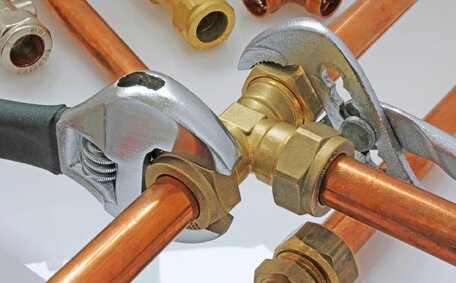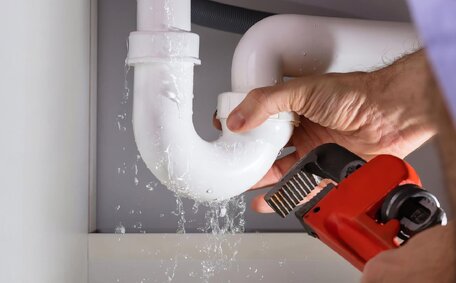Understanding Why Pipes Freeze and Burst
The issue of pipes freezing and bursting occurs when water inside your pipes expands as it turns to ice. Water’s expansion when freezing can easily rupture pipes as the internal pressure exceeds 2000 psi. It’s critical to insulate your pipes to prevent them from freezing and causing damage to your house.
As temperatures drop, the risk of water freezing inside pipes increases if they lack proper insulation. If any pipes lack insulation, the water cools rapidly. At 0°C, water inside inadequately insulated pipes begins to freeze, highlighting the rapid effect of freezing temperatures.
The expansion of freezing water increases internal pressure significantly, emphasizing the need to correctly thaw frozen pipes. Most pipes fail around 300-400 psi. This constant expansion of ice can result in pools of water from a burst pipe, making it crucial to know how to safely thaw your pipes and prevent significant water damage.
Insulation is crucial for slowing heat loss to cold air, preventing pipes from freezing. This helps ensure that water can flow safely through pipes, minimising the risk of your pipes freezing and the likelihood of expansion. Well-insulated pipes are better equipped to withstand cold winters and prevent freezing.
Insulating and heating your pipes, along with sealing openings, reduces the risk of freezing. Should your water tanks still grapple with a frosty dilemma, the Prompt action to help thaw frozen blockages and shutting off your water is critical and can save you from costly damage.
Identifying Which Pipes Are Most Vulnerable
Pipes in certain locations are more prone to freezing. Typically, pipes located in areas behind garage doors or in unheated interior spaces like crawl space basements and attics face the highest risk.
Pipes located within or near walls can quickly become very cold and lose heat during cold snaps. Pipes are especially vulnerable to freezing without proper insulation or sealed openings.
Exposed pipes, as opposed to those buried, are at most risk of freezing first, due to faster heat loss. Pipes near outside spigots are often the first to freeze when temperatures drop, so it’s important to prioritise their insulation.
Identifying and insulating pipes in exterior walls can help prevent bursts. Inspect for potential issues in outside walls and areas like basements, attics, and unheated rooms where a frozen pipe burst might occur. Be vigilant in areas where a frozen pipe can find itself quickly becoming a problem and leading to pipe bursts.
Keeping Pipes Insulated
Proper insulation of pipes is crucial to prevent freezing and potential bursts. Here are some insightful tips keep your plumbing areas secure: ply foam pipe insulators, fibreglass wraps, and implement heat tape.
Foam Pipe Insulators
Foam insulators, such as pipe lagging, are straightforward to fit; measure, cut to size, and wrap the pipe firmly. Securing the seams of pipe insulation with tape enhances stability and effectiveness.
The thick foam layer is there to ensure your water maintains its temperature, and it’s good practice to hinder the brisk transfer of heat from the pipe to the chilly surrounding air. It’s ideal for exposed pipes in unheated areas.
Fibreglass Pipe Wrap
Fibreglass insulation with weatherproof outer layers works well too. Wrap it around pipe ensuring the insulating material overlaps by 2-3cm to maximise thermal retention coming your way. Tape the length of the seam.
This flexible insulation conforms closely to fittings and bends. The fibreglass interior insulates while the exterior resists water.
Heat Tape
Electric heat tape can do frozen pipes good by warming them directly. Spirally wrap the entire length of the pipe with tape, ensuring a 50% overlap for optimum coverage. Plug into a GFCI outlet and set thermostat to 5°C.
It’s crucial to know where your heat tape is situated so you can monitor any potential risks that may damage your plumbing if issues occur. Similarly, call a licensed plumber for professional installation of any bypass systems around your boiler.
Combining insulation, such as foam or fibreglass, with heat tape offers optimal protection and reduces the risk of burst pipes. Take measures to insulate Keep pipes susceptible to the cold during winter.
Using Heat Sources to Prevent Freezing
Employing safe heat sources near frozen areas can also be effective in preventing your pipes from becoming ice blocks during extreme cold. Effective options include:
Wrapping pipes with electric heat tape is one preventive measure against freezing; ensure it’s installed by a licensed electrician. Set the thermostat to 5°C to maintain a safe temperature.
Space Heaters
Direct a space heater to blow warm air at the frozen section of pipe in a cold area and effectively thaw pipes. Position it near frozen pipe sections to avoid overheating combustible materials. Do not leave portable heaters unattended.
Heating Pads
Insulate pipes then meticulously wrap heating pads to avoid use of any open flame and keep hot water from freezing within them. Hook up pads to a GFCI outlet. Monitor closely and do not use open flames or allow direct contact between the heating pad and pipe.
When you apply heat and then power off your heat sources, take safety precautions like keeping areas ventilated, using GFCI outlets, and monitoring regularly. Never use open flames to thaw pipes due to the serious risk of ignition and home safety hazards.
Letting Faucets Drip During Cold Snaps
Keeping a trickle of water flowing from taps during extreme cold prevents pipe freezing. Continual water flow helps keep water freezing at bay, stops your pipes from building up pressure, and reduces the risk of ice blockages.
When temperatures plummet and pipes burst, set indoor faucets to drip continuously at the rate of one drop per second. For your faucets outdoors, do use a constant drip to mitigate the risk of frozen lines.
A steady flow of warm water in the pipes helps to prevent freezing. Warmer water from inside your home mixes with cooler water, circulating and preventing freezing. This practice helps maintain water temperatures inside your pipes above freezing.
Understanding how a slow trickle of water keeps the pipes clear also averts the risk of water solidifying inside the conduits. Stagnant water freezes most readily. Consistent movement makes it less likely for ice to fully form and it’s a good practice to prevent damage to your pipes.
Take care to insulate and wrap any outside faucets, including hose bibs, to retain heat. Dripping alone may not be enough for exterior taps in frigid conditions. Still, keeping water running remains an effective emergency measure.
Adjusting Thermostats for Consistent Heat
Maintaining a steady thermostat temperature can prevent burst pipes in cold weather. Allowing the temperature to drop significantly overnight puts pipes at risk.
Setting your thermostat around 15°C ensures that indoor pipes stay above freezing temperatures. Make sure that warmth permeates through the pipes housed in the walls your home, especially in places such as attics, cellars, and bordering the house’s exterior.
Maintaining consistent warmth throughout your house helps prevent pipes from freezing by reducing temperature fluctuations. This approach also lowers energy bills compared to reheating the areas of your house each morning.
For added protection and expert advice, insulate pipes in unheated zones, leave cabinet doors open to allow heat to circulate, and safely apply supplemental heating during extreme cold.
Knowing When to Call a Professional Plumber
Do not attempt to thaw pipes yourself when you notice signs of freezing or potential bursts; it’s crucial to seek professional assistance. Attempting to thaw or repair burst pipes without proper training can make the situation far worse.
The expert plumbers at St Ives Plumbing are available 24/7 for any enquiries about frozen pipes or emergency repair and preventative assistance. If you spot any of the following issues, call 1300 349 338 or email [email protected] right away:
- Visible cracks, leaks, or ruptures in pipes
- Low or no water pressure
- Pipes are abnormally cold to the touch
- Hissing, rumbling or gurgling sounds from pipes
- Faulty water supply even after thoroughly checking faucets and valves
- Significant drops in water temperature
- Unexplained spikes in water bills indicative of a hidden leak
Call our licensed technicians who have the expertise to manage your plumbing needs:
- Rapidly evaluate the affected pipes
- Determine if thawing is possible or if full replacement is required
- Handle any necessary repairs with precision
- Restore proper water supply and enhance your heating efficiency
- Suggest preventative measures to avoid future frozen pipe incidents
Don’t hesitate to call plumber experts at St Ives Plumbing. We’re available 24/7 to respond quickly to frozen burst pipe emergencies.
Steps to Take if You Have a Burst Pipe
If you discover a burst pipe, immediate action to shut off water is critical to stop flooding and minimise water damage to your property:
- Immediately locate and turn off the main water valve to halt the flow and minimise damage. This is typically near the water metre or main water line’s entry point.
- After stopping the main water flow, turn off the taps to save water and relieve pressure.
- Once water has stopped flowing from the taps, turn them off.
- Check all areas meticulously for signs of a broken pipe and any resultant leaking water. Look for dripping ceilings or walls, pools of water on floors or carpeting, etc.
- Move valuables and electronics away from leaks to prevent damage.
- Promptly submit your request to St Ives Plumbing at 1300 349 338 for swift assistance. You may need to call your local plumber from our 24/7 emergency team to quickly contain the burst and start repairs.
Attempting pipe repairs without proper training can make the situation worse. Our experts can:
- Assess damage and contain the leak
- Determine if pipe replacement is needed
- Extract water to dry out flooded areas
- Make necessary repairs with precision
- Restore proper water supply once fixed
Check with your home insurance provider about coverage for burst pipes, as we offer this to our customers. Contact St Ives Plumbing to understand our terms and conditions and learn more about our services.






